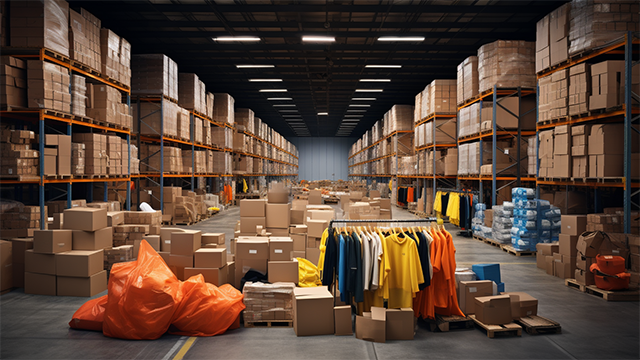3 min read
Meet the Demand for Reverse Logistics Solutions
![]() Dev Pro Journal
February 12, 2024 10:05:32 AM EST
Dev Pro Journal
February 12, 2024 10:05:32 AM EST

See why planning and implementing effective reverse logistics solutions has never been more crucial for your clients and how to build a solution with the functionality businesses need.
Over the past several years, there has been a marked increase in supply chain disruptions. The COVID-19 pandemic, natural disasters, political instabilities, geopolitical tension, trade disputes, cybersecurity threats, raw material shortages, and demand fluctuations all created challenges unlike the space had never seen before. While enterprises worked to improve logistics and build more resilience into their operations, many overlooked the importance of reverse logistics. They now need the expertise of a technology solutions provider (TSP) to address this increasingly important part of their operations.
What is Reverse Logistics?
Reverse logistics involves moving goods from their final destination back to the manufacturer or seller for returns, repairs, remanufacturing, refurbishment, recycling, or disposal. It consists of managing and handling products after they have been delivered to the end user, creating a reverse flow in the supply chain.
Several factors make efficient reverse logistics processes crucial for organizations today:
- Booming E-Commerce Growth
Mordor Intelligence estimates the European e-commerce market to be at USD 647.34 billion and will grow to USD 951.16 billion by 2029. That’s a compound annual growth rate of 8% during the forecast period. The same study reveals that e-commerce accelerated during the pandemic. The proportion of online shoppers grew from 55% in 2012 to 75% in 2022.
The trend continues, with businesses bound by engagement solely in physical stores now taking advantage of the movement by offering subscription boxes and selling on social platforms. This increased demand results in more shipments and, as a result, more e-commerce returns. Logistics Matter reports, “The returns rate is 8% for items bought in brick-and-mortar stores. This rate jumps to 25-40% of items purchased online.”
Quality customer service is the cornerstone of building a base of loyal customers, and loyal customers significantly impact the bottom line. Return services play a crucial role in customer service. Additionally, managing returns is imperative to revenue operations, inventory tracking, and avoiding monetary losses due to lost products.
- Corporate Sustainability
According to the European Environment Agency, each European citizen produces 4.8 tons of waste yearly, and 49% of municipal waste is recycled. Recycling rates vary for waste streams, reaching only 39% for electrical and electronic waste.
By integrating reverse logistics processes, such as product returns, remanufacturing and refurbishing, recycling and disposal, warranty repairs, recall, and end-of-life product management, you can help your clients improve those statistics while contributing to the community’s health and the environment.
- Cost Control
Increasing costs are forcing businesses to look for more ways to save. Getting smart about recycling and reusing items like pallets, containers, and returnable boxes can easily cut costs. Additionally, it will make for a more efficient and productive workforce, cutting out the time it takes for employees to search for containers and interruptions to production because containers aren’t available. It can also save dollars on raw materials costs when recycling or reuse is an option.
How to Make Reverse Logistics Work
A comprehensive reverse logistics solution requires integrating various components to ensure a seamless and sustainable return management approach. Here’s a breakdown of critical components to make reverse logistics work effectively:
- Communication Solutions
The demands on an enterprise’s customer service teams are increasing, especially with a larger volume of returns. Intelligent chatbots leveraging artificial intelligence (AI) allow customers to access the information they need to initiate the returns process on their own. In fact, according to Zendesk, 75% of customers say self-service is a convenient way to address customer service issues.
Effective communication with supply chain partners is also vital for successful reverse logistics. Beyond traditional email and phone communication, explore purpose-built applications and file management systems for information sharing. These tools facilitate seamless communication regarding returns, shipping orders, and shipment tracking. Data sharing between partners is necessary for a transparent and collaborative reverse logistics process.
- Warehouse and Returns Management Processes
Implementing efficient warehouse and returns management processes is essential. Ensure you have an application integrated with the warehouse management system (WMS) designed explicitly for returning items to inventory. The WMS should guide workers on labeling, stocking returned items, sending them for inspection or refurbishment, and crediting customers for returns or recyclable materials. Real-time tracking of items should begin as soon as they enter the reverse logistics process.
- Data Collection Enhancements
Automating processes can allow enterprises to accurately track items, manage inventory, and expedite the returns process. You can implement familiar solutions, such as RFID and mobile carts, to automate and streamline various processes.
RFID tags offer consumers, customer service, and management increased transparency into returns, tracing items on their journey through the reversed supply chain and reducing the chance of errors during the receiving process.
Mobile carts can significantly improve the efficiency of a warehouse’s receiving process and increase the precision with which returned products are handled by offering real-time data access, instant inventory updates, task management and workflow optimization, reduced manual errors, better-informed business decisions and more.
By integrating these components into your reverse logistics strategy, you can boost efficiency, reduce costs, and meet the evolving demands of both customers and supply chain partners. A well-designed reverse logistics system improves customer satisfaction and contributes to sustainable and responsible business practices.
Elevate your business, embrace innovation, and redefine what’s possible in reverse logistics. Start your journey to success now.



